Superstructure
Oct 23, 2010
Apparently, the old City Hall building in Philadelphia needs a lotta lotta work.
Oct 23, 2010
Apparently, the old City Hall building in Philadelphia needs a lotta lotta work.
Dec 24, 2010
These men were up on the roof working with the crane last Saturday. The guy in the black hat really wanted his picture taken and kept posing dramatically, which the guy in the red hat thought was pretty funny.
Jan 7, 2011
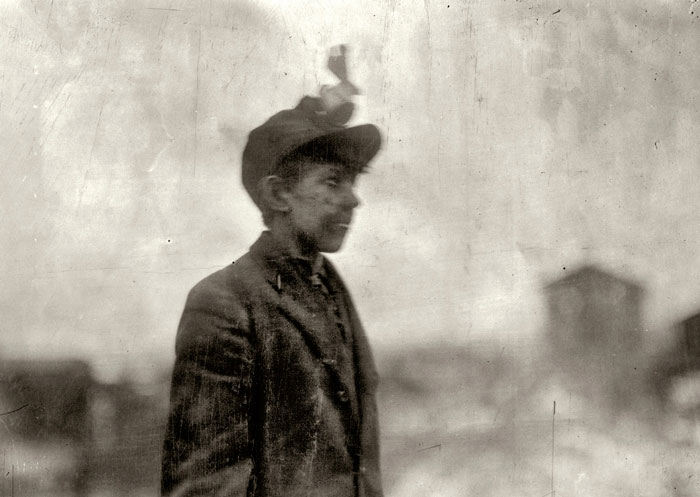 Arthur Havard was fourteen years old in 1911 when his picture was taken at work one day, outside the #6 shaft of the coal mine in South Pittston, Pennsylvania.
Arthur Havard was fourteen years old in 1911 when his picture was taken at work one day, outside the #6 shaft of the coal mine in South Pittston, Pennsylvania.
Havard's job was to drive the mules that hauled coal along tracks from the working face deep in the mine all the way up to daylight. Many boys worked in the mine for years as mule drivers until they finally grew big enough to wield a pick and work as regular miners.
It was another world back then. Yet it wasn't all that long ago; Havard's children were born in the 1920s, and some are still alive today.
Here is a description of how children worked in the mines of Pennsylvania, provided by the son of a mule driver like Havard:
My dad was a 'mule driver' in a Western Pennsylvania bituminous coal mine as a youth. His job was to guide the mule and coal cart on tracks out of the mine. On the way out, he would make sure that no clumps of coal would fall off the cart. If they did he would have to pick up the coal, climb to the top of the load and replace the fallen coal on top of the load. The coal company had a bell at the exit tunnel hanging down to ring as it was hit on the way out. If the bell did not ring, the team who cut, dug and loaded the coal would not be paid for a full load. He could never let that bell not to ring. That team of miners were his relatives and neighbors in the same Coal Patch.
Jan 28, 2011
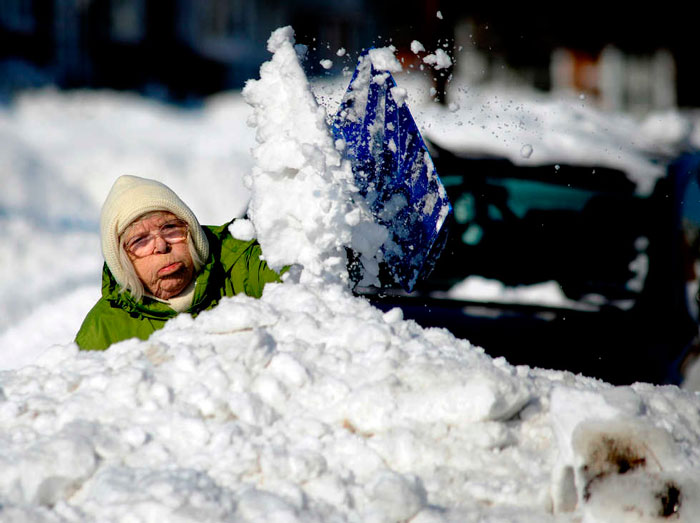 The way I see it, there's not much point in digging out my car before the plow comes around, and it hasn't shown up yet. So the work Margaret White took care of today is still ahead of me, waiting for another day. I'm okay with that.
The way I see it, there's not much point in digging out my car before the plow comes around, and it hasn't shown up yet. So the work Margaret White took care of today is still ahead of me, waiting for another day. I'm okay with that.
Our street, Kater Street, is what they call a "small street" in Philadelphia. It's plenty long--almost river-to-river, the entire length of Center City--but it's narrow, narrow, narrow. Regular-sized garbage trucks and snowplows can't fit through. The city operates special skinny garbage trucks for us small-street folks, and I once saw what looked like a lawn tractor from the parks department, chugging down the block with a plow fitted to its front. However, that was back in December.
Today, the kids on the block built a snowman in the middle of the street, with a carrot for a nose and almonds for eyes. He's not blocking any traffic. It's quiet here, with the cars all shrouded and still. If spring comes before the snowplow does, if the snowman has a chance to just shrivel up in the afternoon sun . . . well, it could save me a lot of shoveling.
Feb 9, 2011
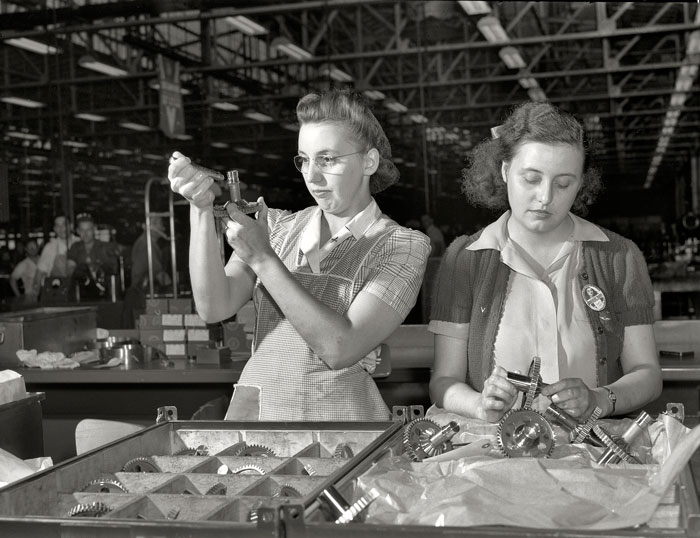 In 1942 in the Melrose Park Buick plant outside Chicago, "vital cogs in America's war machine"--that's Office of War Information talk for airplane-engine gears--are being inspected for defects. Dorothy Miller, at left, checks a vital cog with aid of a tiny flashlight in her right hand. Sylvia Dreiser, at right, thinks about whatever it is she's thinking about, which may not be cogs at all. I'd rather ride in an airplane powered by Dorothy's cogs.
In 1942 in the Melrose Park Buick plant outside Chicago, "vital cogs in America's war machine"--that's Office of War Information talk for airplane-engine gears--are being inspected for defects. Dorothy Miller, at left, checks a vital cog with aid of a tiny flashlight in her right hand. Sylvia Dreiser, at right, thinks about whatever it is she's thinking about, which may not be cogs at all. I'd rather ride in an airplane powered by Dorothy's cogs.
If you click on this photo to get the large version and look at it closely, you may be able to see that both women's hands are slathered in oil. In fact, you have to wonder how many times a day did that penlight squirt right out of Dorothy's slippery fingers. Also, for what it's worth, Dorothy is wearing a hairnet and Sylvia isn't.
Mar 24, 2011
Mar 25, 2011
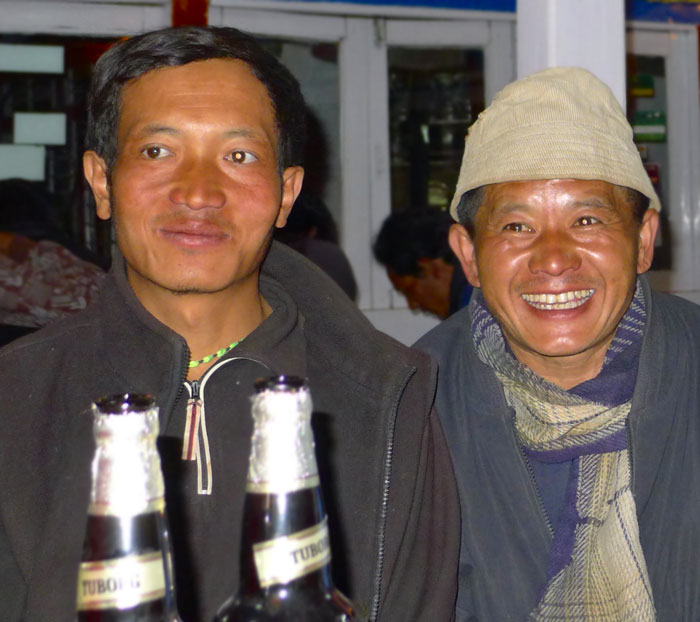 There are two kinds of trekking in Nepal: teahouse trekking through populated countryside and tent trekking, which can venture into uninhabited mountain realms of rock and ice. Both kinds involve a group of tourists walking on trails for days or weeks, led by a guide and supported by porters.
There are two kinds of trekking in Nepal: teahouse trekking through populated countryside and tent trekking, which can venture into uninhabited mountain realms of rock and ice. Both kinds involve a group of tourists walking on trails for days or weeks, led by a guide and supported by porters.
The trekkers in the group usually carry only daypacks as they walk, containing bottled water, a fleece and rainjacket, toilet paper, and little more. Porters for teahouse treks carry duffels containing clothes and sleeping bags; for tent treks, they also carry food, camping gear, and perhaps mountaineering equipment. For a teahouse trek, there is one porter for every two or three trekkers in the group. For a tent trek, the ratio may be much higher.
Porters are ridiculously strong, fit, sturdy, reliable people. Most but not all are male, though they are not big men; some are barely five feet tall. They load up with 60 or 80 or even 100 pounds on their backs and oftimes finish the day's hike long before the lightly-laden trekkers. Many of them come from extremely remote villages, where subsistence farming is still the mainstay of life and there is little or no opportunity to earn cash income. Many porters, like most Nepalis, are illiterate. Work with the trekkers is seasonal and extremely irregular, and the pay is poor.
The two porters who accompanied our little group came from the Forbidden Kingdom of Mustang, high in the Himalayas near the Tibetan border. The provincial government of Mustang keeps the district almost closed to foreigners by charging so much for visas that only the wealthiest tourists can visit. Each year, as trekking season comes around, would-be porters in places like Mustang have to somehow come up with cash money--often borrowed--for bus fare to Kathmandu, where they gather in the airport parking lot to be looked over by trekking guides and perhaps chosen for work.
The guide for our group, Binaye, a Nepali who usually worked for a German tour company but who handled our trip on his own, went out to the airport to hire porters a few days before we were scheduled to arrive. He knew nothing about the two men he chose and had never met them before; he liked their attitude, he said, and they didn't smell of booze. From their homes in Mustang, they had walked four days to the bus stop and then ridden the bus for three days to Kathmandu, with no guarantee of work.
Both of them were among the pleasantest, hardest working people I've ever met.
After three days' trek, we reached the village of Ghorepani, a trekking hub. Many routes lead out from Ghorepani into the high Himalaya around Annapurna. The place bustled with trekkers coming and going, and over the years, trekking-related income had apparently led to public amenities not evident in smaller villages. Ghorepani had electricity and a medical clinic of some kind, and also a school.
Outside the school was a playground, a paved yard with a basketball goal and a volleyball net. Mule trains and horse caravans trooped across the back of the lot. Wastewater from a restaurant kitchen spilled in from the front.
As we settled into town to catch our breath and wait for dinner, porters were out in the playground playing volleyball. They had set down their loads, taken off their boots, and somehow found the energy to run and jump and dive and enjoy the late-afternoon sun.
Porters and trekkers eat separately and mostly have little communication or contact; per tradition, we come together for drinks the last night of the trip. That's when I learned that Beem, the porter with a hat and scarf and permanent smile, had five children, just like me.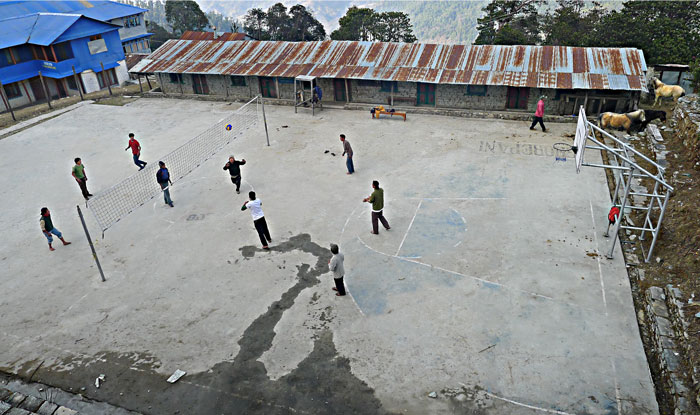
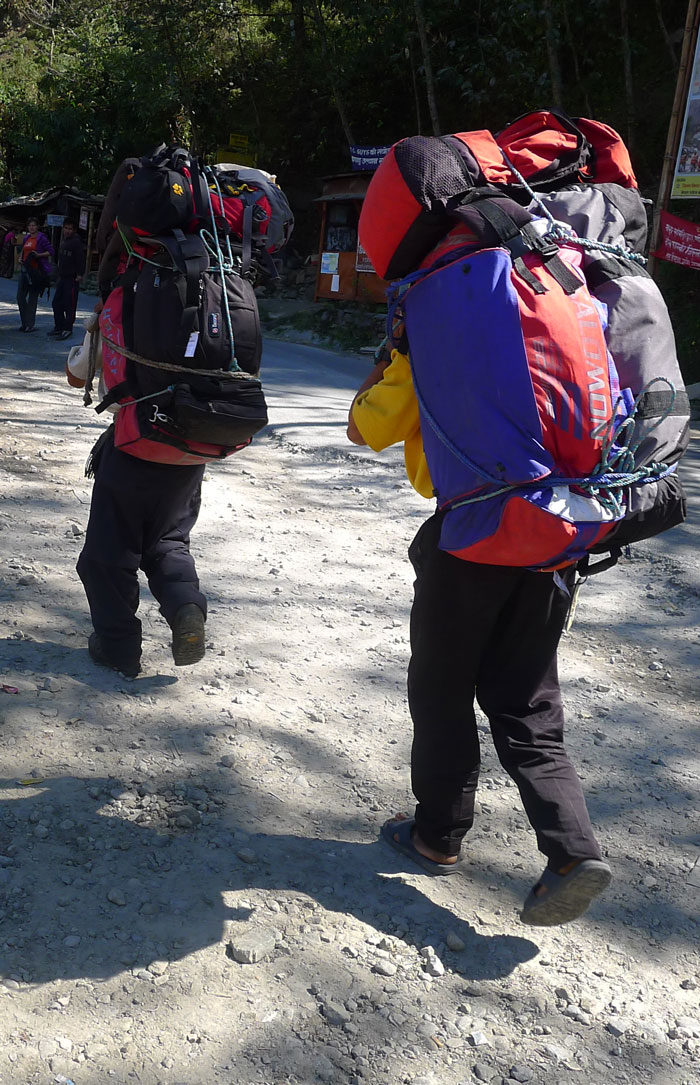
May 22, 2011
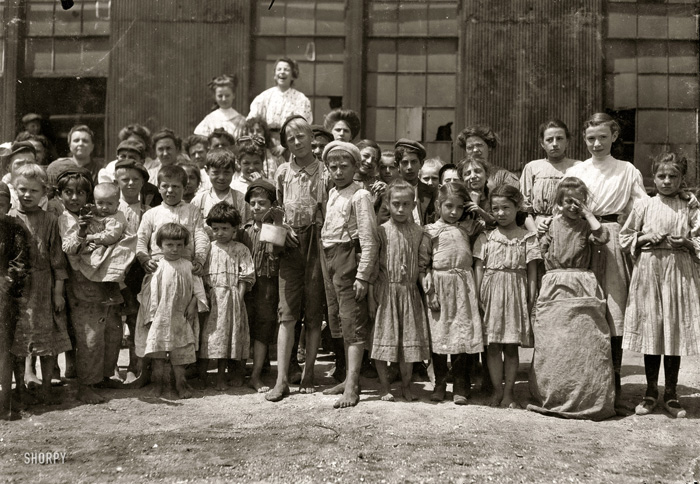 The caption is missing from this Lewis Hine photo in the Library of Congress, but it was taken in the year 1900 and is believed to show children who worked at a seafood-packing plant in Baltimore.
The caption is missing from this Lewis Hine photo in the Library of Congress, but it was taken in the year 1900 and is believed to show children who worked at a seafood-packing plant in Baltimore.
The Baltimore seafood packers were immigrant families who called themselves Slovonians; they came mostly from regions of Eastern Europe that would later become Czechoslovakia and Yugoslavia. After a few years in Baltimore, many relocated to Biloxi, Mississippi, which became the center of American seafood processing through much of the twentieth century. There is still a Slovonian Society and Social Club in Biloxi.
Lewis Hine's photographs of working children were part of his eventually successful campaign to end child labor in the United States. This picture is a bit different, however. If you click on the photo to view a larger version, you will notice that several of the children are clearly too young to pack fish; one is too young to walk. And unlike Hine's usual subjects, some of these children are smiling, even laughing.
Maybe the picture is a reject from the anti–child labor campaign, hence the missing caption. Perhaps the children were families of seafood packers, but not necessarily working themselves as seafood packers. But it is clear from Hine's other photographs that at least some of these children did in fact work long, miserable hours in the wretched factory they are posed in front of. They nonetheless laugh and smile, we have to assume, because that's what children do.
Aug 9, 2011
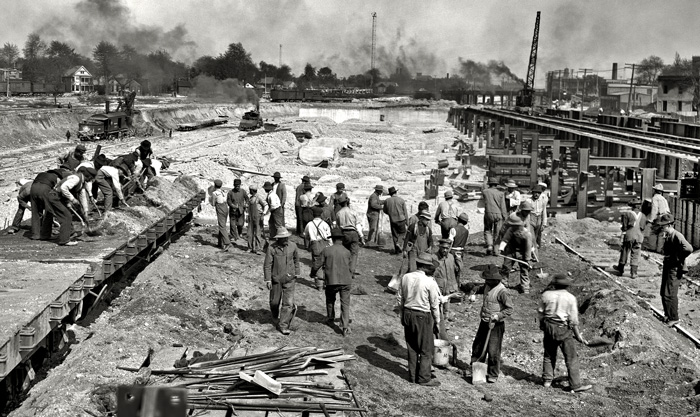 In 1910, most of the excavation work for the new Michigan Central railroad station in Detroit was still being done with the loathesome short-handled shovels. In the background of this photo, however, we can glimpse the excavators of the future: smoke-belching job-killers, aka steam shovels.
In 1910, most of the excavation work for the new Michigan Central railroad station in Detroit was still being done with the loathesome short-handled shovels. In the background of this photo, however, we can glimpse the excavators of the future: smoke-belching job-killers, aka steam shovels.
The men are wearing hats, but not hard hats.
The Michigan Central Station survives today, I'm told, "if just barely." Short-handled shovels, too, are still around, in real life but more spectacularly in the blues.
Feb 13, 2012
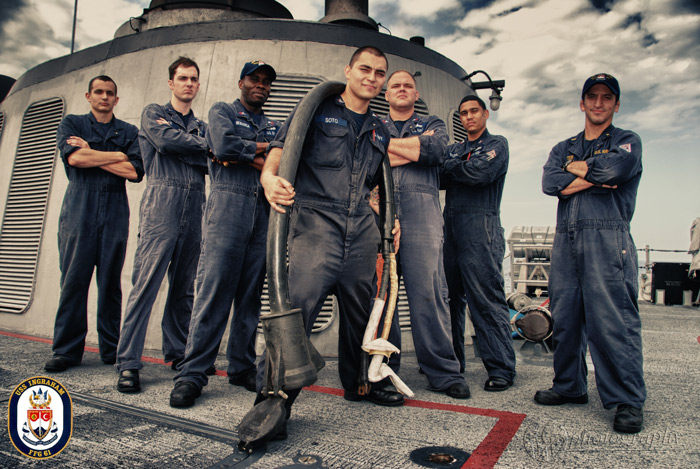 The electrical engineers of the navy frigate USS Ingraham pose for their official cruise portrait. From left to right: EM3 Huggins, EM3 Miller, EM1 Nkwanga, EM3 Acostasoto, EM1 Gillespy, EM2 Genaovargas, Ensign Stein.
The electrical engineers of the navy frigate USS Ingraham pose for their official cruise portrait. From left to right: EM3 Huggins, EM3 Miller, EM1 Nkwanga, EM3 Acostasoto, EM1 Gillespy, EM2 Genaovargas, Ensign Stein.
The Ingraham left its homeport of Everett, Washington, last September for a six-month deployment with an international force trying to suppress drug trafficking in the waters off Central and South America.
The thing around Acostasoto's neck is an electrical shore power cable.
Feb 16, 2012
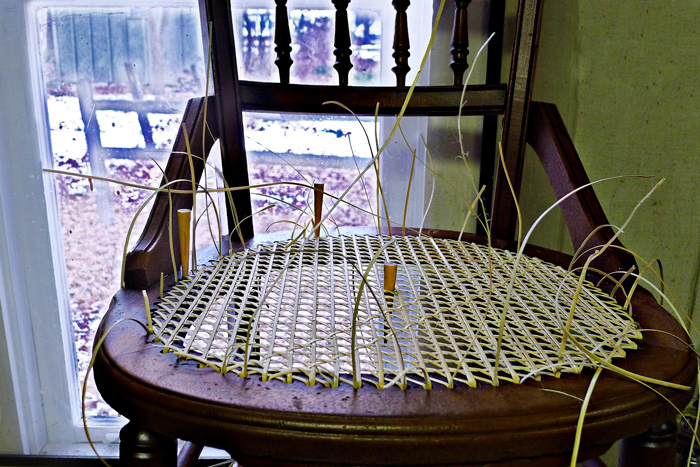 Another hour's work, and Bernard Zike will have the seat of this chair completely restored. People from all over New England bring worn-out old chairs to Bernard's workshops in Warren and Portland, Maine, where he and his partner, Marion Puglisi, work centuries-old caning and rushing techniques, often with reeds they've harvested themselves from local ponds.
Another hour's work, and Bernard Zike will have the seat of this chair completely restored. People from all over New England bring worn-out old chairs to Bernard's workshops in Warren and Portland, Maine, where he and his partner, Marion Puglisi, work centuries-old caning and rushing techniques, often with reeds they've harvested themselves from local ponds.
Would-be apprentices from all over the country seek them out in hopes of mastering the craft, though many will give up their dreams when they learn how much patience is required. After more than twenty-five years of experience with traditional tools and all kinds of natural seating, it still takes Bernard almost a full day of work to repair a single chair bottom.
This is one of Bernard and Marion's winter chairs; it will spend the winter in their shop. It belongs to some of Maine's summer people, who drop off broken chairs when they close up their summer homes in the fall, with the expectation that when they reopen their summer homes next spring, they can reclaim the chairs, and they'll be good as new.
Mar 28, 2012
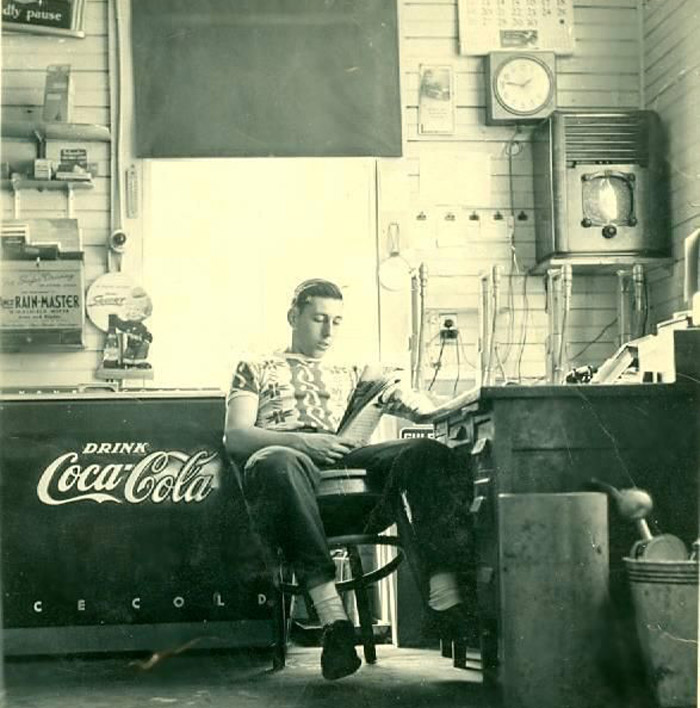 William Pinkerton, back in the day, hard at work at the dispatch desk at Bud Wood's taxi service in Rockland, Maine.
William Pinkerton, back in the day, hard at work at the dispatch desk at Bud Wood's taxi service in Rockland, Maine.
Apr 5, 2012
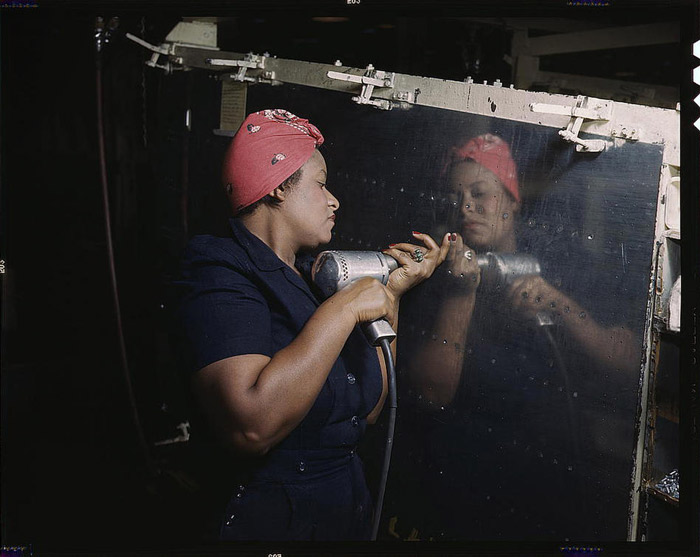 In February 1943, this unnamed woman was at work in the Vultree aircraft plant in Nashville, Tennessee, building a Vengeance Dive-Bomber.
In February 1943, this unnamed woman was at work in the Vultree aircraft plant in Nashville, Tennessee, building a Vengeance Dive-Bomber.
Among the hundreds of thousands of photos commissioned by the government in the 1930s and early 1940s to document economic-recovery programs and the war effort, only a handful, including this one, were in color. After three-quarters of a century, the color images seem to suggest a world that is much more familiar to us today, much less shadowy and distant than the shades-of-gray America that is portrayed so dramatically in the more famous black and white works of the era.
Aircraft parts–fuselage panels, wings, and doors–are still manufactured today at the Vultree site in Nashville, which is now operated as part of the Vought subdivision of Triumph Aerostructures.
Apr 27, 2012
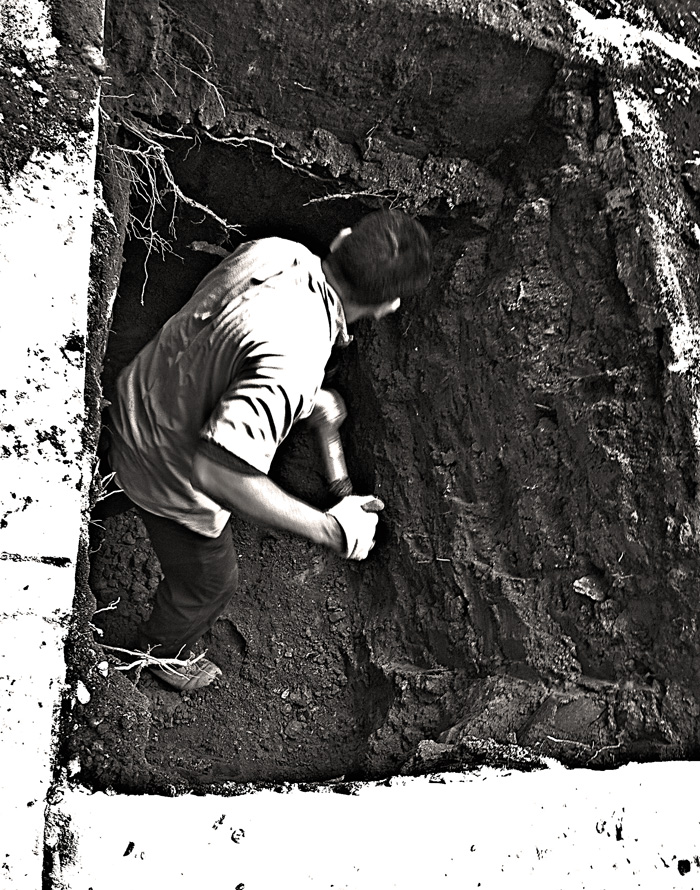 "Video pipe specialist," says the sign on the side of Mr. D's plumbing truck. "We can see underground."
"Video pipe specialist," says the sign on the side of Mr. D's plumbing truck. "We can see underground."
The truck and a backhoe blocked Kater Street for most of the day yesterday, but the job didn't look too video-intensive. According to the man with the shovel, who ought to know, "a couple of feet" of sewer line needed replacing under the sidewalk in front of a house. According to the new owner of the house, the problem had been picked up during a pre-sale inspection, forcing the old owner to foot the bill. "Up to a limit," said the new owner. "This just better not go over the limit."
By late afternoon, the backhoe had filled the hole, and the new owner was standing in his new doorway, roller and empty paint tray in one hand, phone in the other. "It went great," he said, while he texted one-handed. "Soon as I finish the painting we can move in."
May 10, 2012
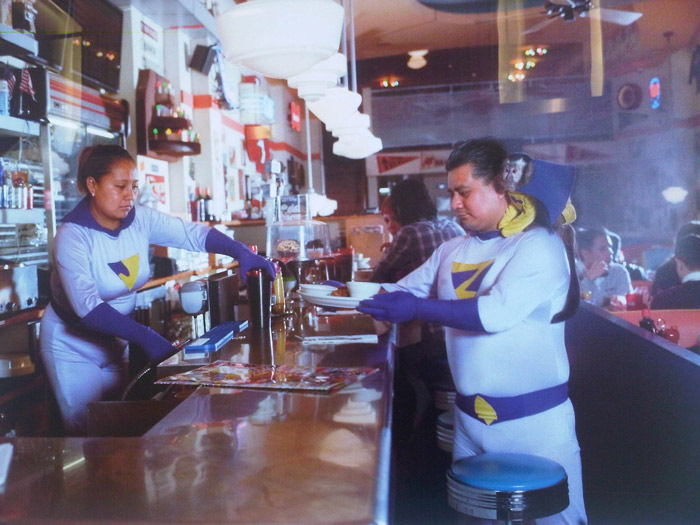 In the eye of Mexican photographer Dulce Pinzon, the superheroes of the twenty-first century include millions of Mexican immigrants in the United States, including Elizabeth and Enrique Alonso, shown here. These men and women show their super-sized courage and devotion when they leave home and family to live among strangers in a strange land, working ferociously hard at the hardest jobs, all so they can send remittances to their families back home. In 2009, when Pinzon dressed the Alonsos as The Fantastic Twins to reveal their superhero status to everybody around them at their workplace, in a Manhattan restaurant, they were sending home $400 a week to support their family in Puebla, Mexico.
In the eye of Mexican photographer Dulce Pinzon, the superheroes of the twenty-first century include millions of Mexican immigrants in the United States, including Elizabeth and Enrique Alonso, shown here. These men and women show their super-sized courage and devotion when they leave home and family to live among strangers in a strange land, working ferociously hard at the hardest jobs, all so they can send remittances to their families back home. In 2009, when Pinzon dressed the Alonsos as The Fantastic Twins to reveal their superhero status to everybody around them at their workplace, in a Manhattan restaurant, they were sending home $400 a week to support their family in Puebla, Mexico.
May 29, 2012
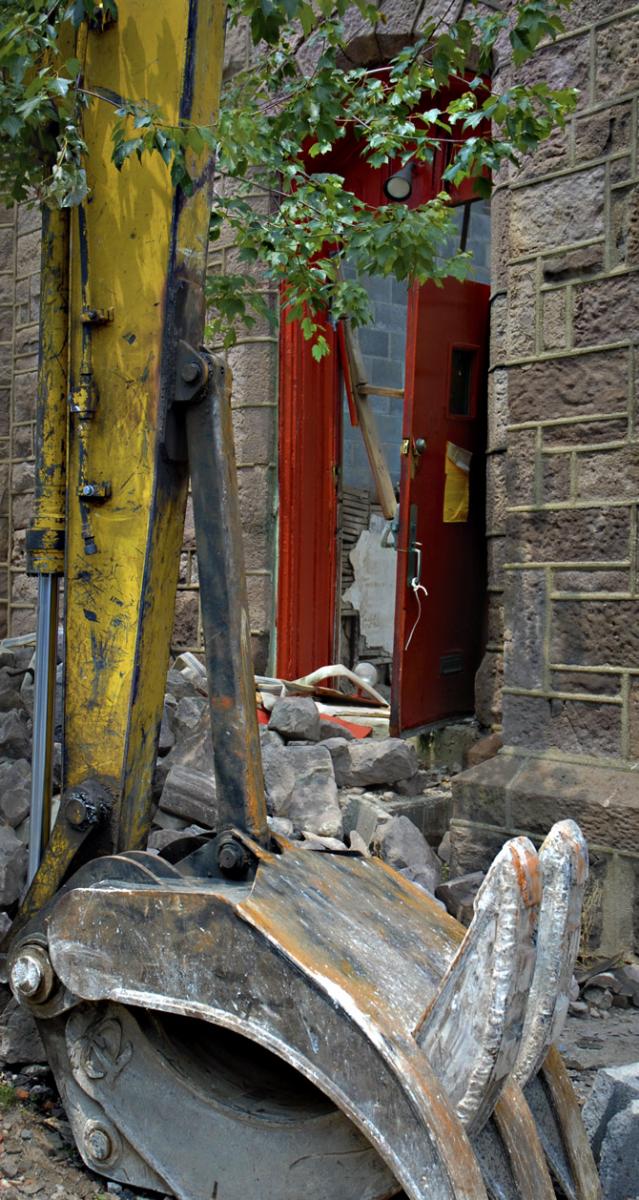
The machine that's demolishing Mt. Olive AME Church in the neighborhood is something you can rent in New Jersey. The jaws at the business end of the thing are heavy-duty grapples; you rent a regular excavating machine on caterpillar treads, remove its digging bucket, and pin on the grapple. The two-tined jaw opens and closes against the stationary three-tined jaw, which is reinforced, as seen here, with a rod called, appropriately enough, a stiff arm.
The cultural and economic forces that are demolishing Mt. Olive AME Church and a whole host of other churches in the neighborhood are something else again. These church buildings, many of them built from stone like this one, have sat here for a hundred years or so, sometimes changing denominations as the nearby population changed. The latest wave of immigrants to the neighborhood doesn't seem very churched at all, and so the old buildings get put on the market. Developers snatch them up and tear them down for a chance to build several new houses at once, in a part of the city that's already densely built. New houses--row houses--sell readily here to people who want to walk to work and/or to stores and restaurants. The new residents evidently are not interested in walking to church.
Soon, the excavator and its grapple will be loaded on a truck to go back to the heavy equipment lot in New Jersey, and we'll see five three-story row houses rise up on this lot, with squared-off bay windows and ten-year tax exemptions.
Jul 7, 2012
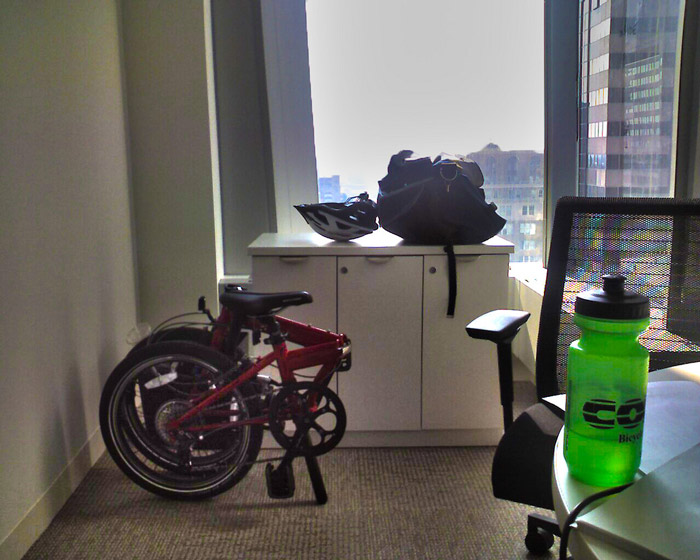 Office with a view and a bicycle.
Office with a view and a bicycle.
Aug 9, 2012
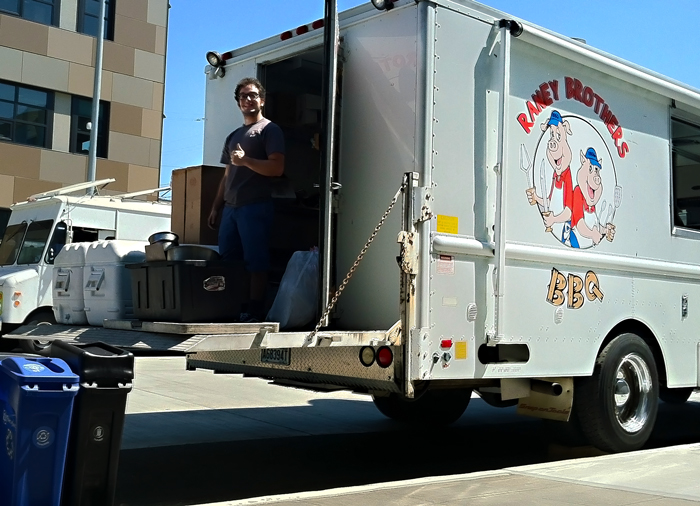 Hank interrupts his cleanup work to give us a thumbs-up from the back of the Raney Brothers BBQ truck in downtown Seattle.
Hank interrupts his cleanup work to give us a thumbs-up from the back of the Raney Brothers BBQ truck in downtown Seattle.
Aug 30, 2012
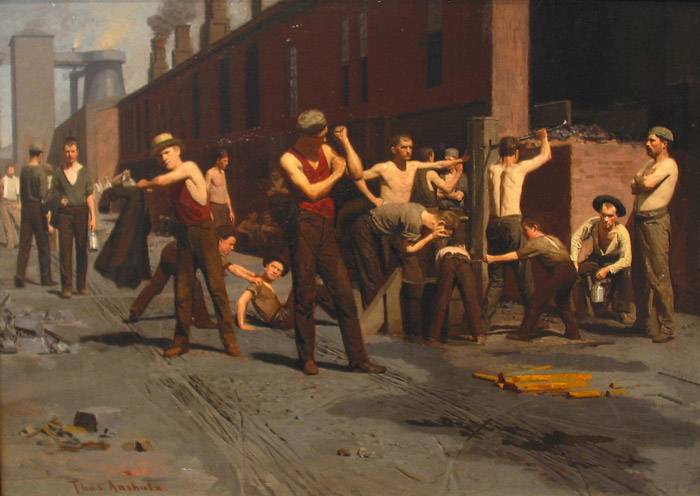 In 1881, this painting earned Thomas Anshutz an award from the local arts establishment, as embodied then by the Philadelphia Sketch Club. The Sketch Club honored Ironworkers' Noontime as the year's "best carefully finished study." According to the minutes from the meeting at which the award was presented, Sketch Club members talked at length about how well Anshutz had learned the style of painting taught by his teacher, club founder Thomas Eakins, and they also talked at length about the painting's extremely unusual subject matter.
In 1881, this painting earned Thomas Anshutz an award from the local arts establishment, as embodied then by the Philadelphia Sketch Club. The Sketch Club honored Ironworkers' Noontime as the year's "best carefully finished study." According to the minutes from the meeting at which the award was presented, Sketch Club members talked at length about how well Anshutz had learned the style of painting taught by his teacher, club founder Thomas Eakins, and they also talked at length about the painting's extremely unusual subject matter.
It's the subject matter that distinguishes the painting today; it's believed to be the earliest American artwork depicting industrial life. Anshutz had been born and raised along the Ohio River near the foundries of Wheeling, West Virginia, where he did the sketches for the painting. He presented the ironworkers as individuals, each using his noon break for his own purposes, despite the overall grime and grit of the surroundings.
The artists in the Sketch Club thought this approach was "needlessly confrontational."
Wheeling's ironworks are now defunct, and the city has been in decline since the 1930s. The old foundry sites along the riverfront are currently promoted for "heritage tourism activities."
Sep 1, 2012
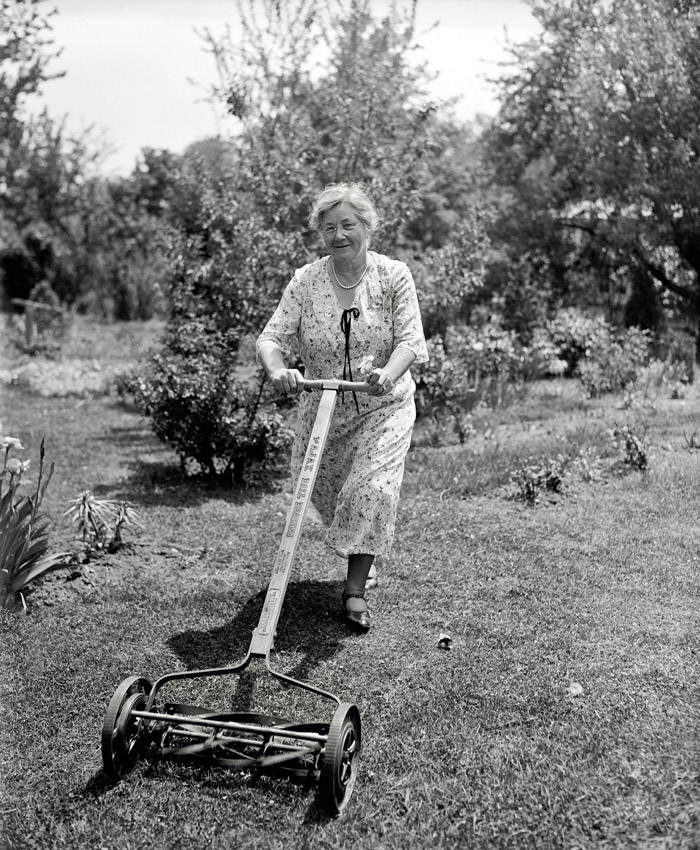 In the archives of the old Harris & Ewing photo studio in Washington, D.C., is the glass negative for this picture, with no caption information whatsoever.
In the archives of the old Harris & Ewing photo studio in Washington, D.C., is the glass negative for this picture, with no caption information whatsoever.
What think you? A posed shot to promote new lawnmowers with Ajax Ball Bearings? Political imagery to promote a candidate with hard-working American (grass)roots? Somebody's aunt?
1920s? 1940s?
Couple of thoughts: Years ago, we lived in a neighborhood of Tuscaloosa, Alabama, where most of our neighbors were older people. By then, lawnmowers had gasoline engines, but I recall that pushing them was considered women's work. More recently, when we lived in Maine, I often saw older couples out in the morning clearing their walks with gasoline-powered snowblowers. The division of labor for this task was that the man walked behind the snowblower while the woman worked alongside with a shovel.
What I like best about this picture: the pearls.
Sep 30, 2012
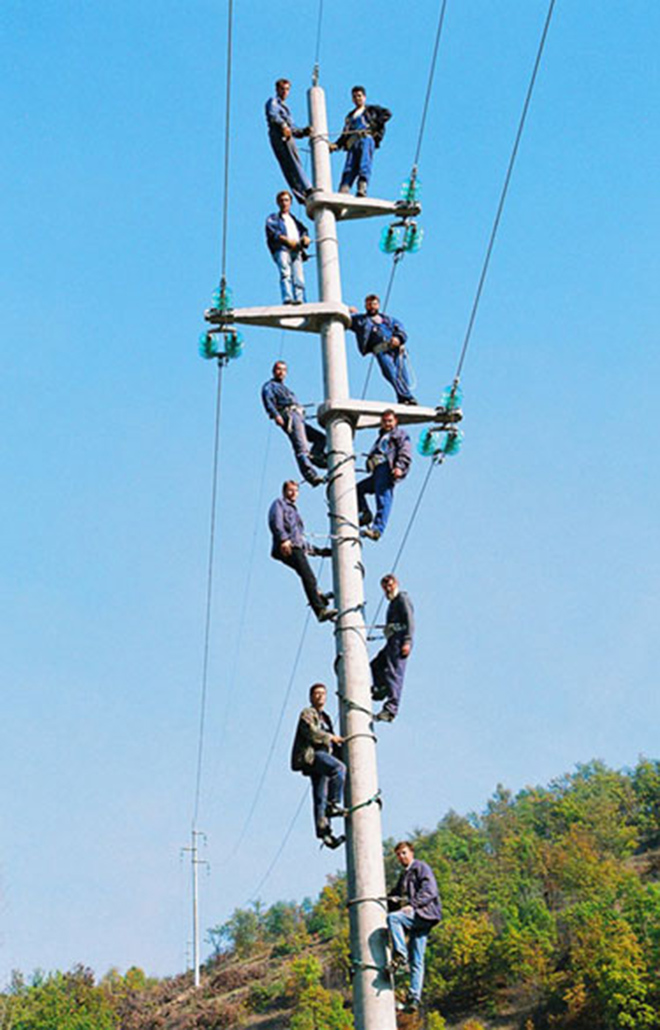
In attempting to learn what the photo above was all about, I came across the two pictures below; at left is a graduation ceremony at an electrical lineman school, while at right is a pole-climbing demo from a Power Day celebration. Based on this research, I'm prepared to say with some but not complete certainly that the guys in the top photo are doing nothing more than showing off their considerable skill.
Also, based on this research, I have begun to learn a little about lineman school. Historians of electrification tell us that during the early days of our power grid, approximately one out of every three linemen was electrocuted or fell to his death at work. Back then, obviously, the job appealed to people with a very high tolerance for risk-taking, and even today, people who are cautious and risk-averse by nature will have trouble forcing themselves to climb fifty or a hundred feet into the air and fiddle with live electrical wires. Thus, lineman school was created to teach daredevils to take risks in a less risky way.
The instructor of the class at lower left is Ken Bushman, a licensed hypnotherapist as well as a long-time lineman. He teaches breathing exercises as an aid to focus while working in the air. This particular class included fifty students, forty-six of whom made it through to graduation: "laid off construction workers, a food scientist in need of a change, a Zen monk, ex-cons, warehouse box movers, recovering addicts, veterans of Iraq/Afghanistan, the children of border crossers, descendants of American slaves, slackers, jokers, and serious men who love to work hard."
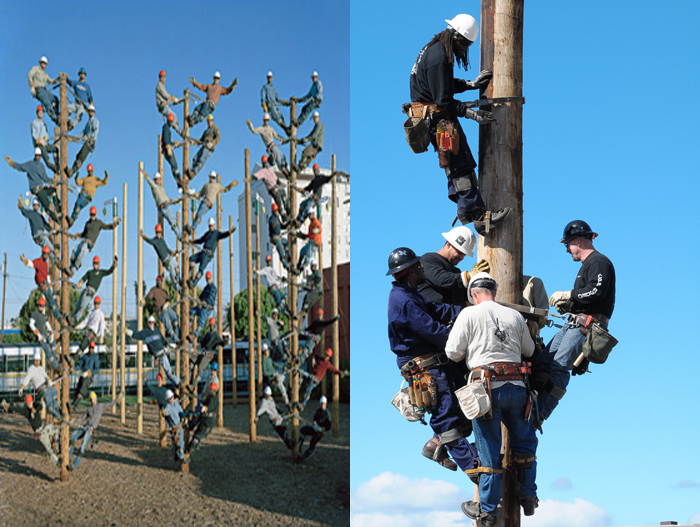
Nov 12, 2012
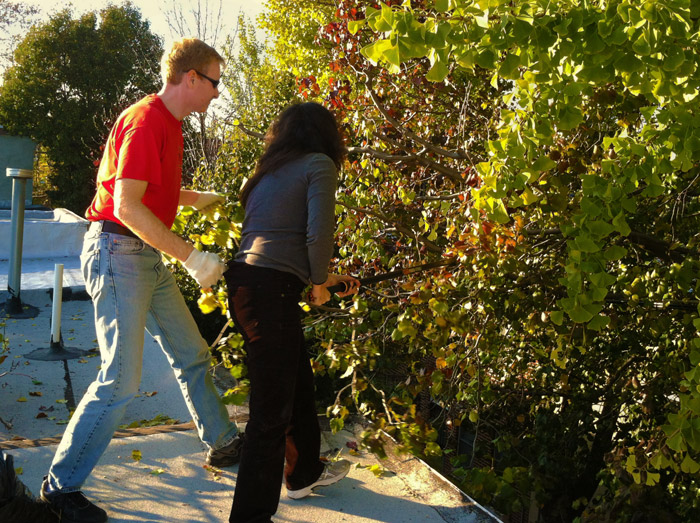 When you get a day in November that's t-shirt warm, it just seems right to get up on the roof. There were drainspouts to clear and trees to trim, debris to sweep up and . . . pictures to take.
When you get a day in November that's t-shirt warm, it just seems right to get up on the roof. There were drainspouts to clear and trees to trim, debris to sweep up and . . . pictures to take.
Today's rooftop picture features our neighbors Carolyn and Frank; Carolyn works the pole trimmer while Frank hooks a finger in her beltloop to keep her safe.
Looking into the treetops, it became obvious that this year's fall weather has mostly been so mild that the leaves are only just now beginning to behave fallishly. But we trimmed the trees back so far that almost all the remaining leaves will eventually drop on the street or the sidewalk, not on top of the houses.
Nov 28, 2012
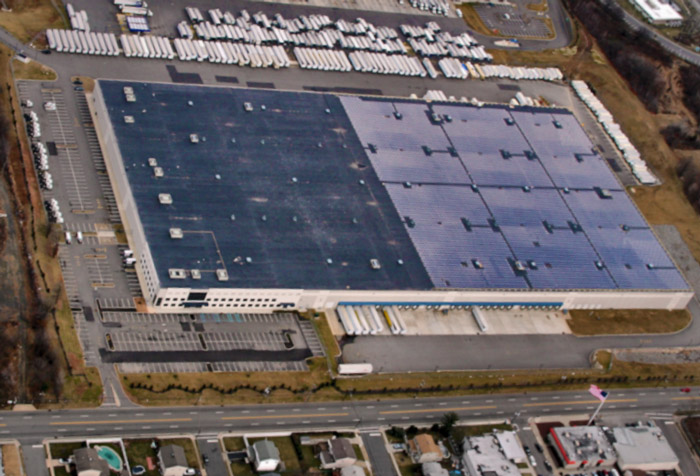 It does seem like we don't make anything in America any more, but that's not completely true. Right here under this roof in Easton, Pennsylvania, Americans make Crayola crayons and . . . Silly Putty. Not only that, but up the road a few miles they've got a factory outlet store and a Crayola Discovery Center, which is basically a crayon-themed theme park.
It does seem like we don't make anything in America any more, but that's not completely true. Right here under this roof in Easton, Pennsylvania, Americans make Crayola crayons and . . . Silly Putty. Not only that, but up the road a few miles they've got a factory outlet store and a Crayola Discovery Center, which is basically a crayon-themed theme park.
Still and all, this factory doesn't look quite right. You can't make a lot of crayons without heating up a lot of wax–shouldn't they have some serious smokestacks here?
Jan 9, 2013
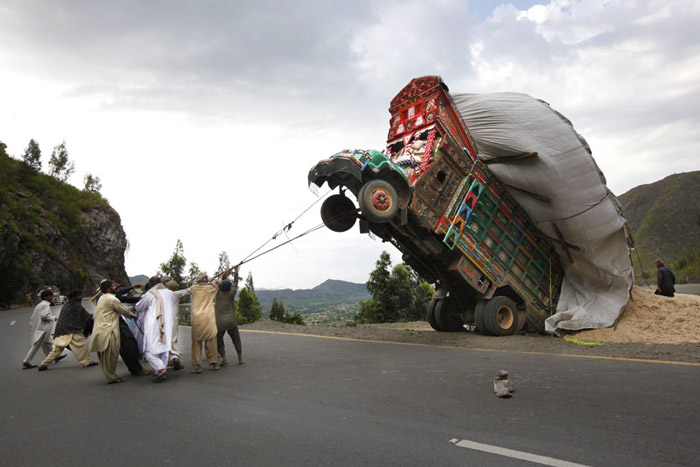 There was evidently just a little too much weight in the back for this truck to navigate the winding mountain road through the Malakand district north of Islamabad in Pakistan. The men tugging on ropes could not right the vehicle, but they were able to keep it from completely flipping over while other men worked to lighten the load, which was wheat straw intended for use as animal feed.
There was evidently just a little too much weight in the back for this truck to navigate the winding mountain road through the Malakand district north of Islamabad in Pakistan. The men tugging on ropes could not right the vehicle, but they were able to keep it from completely flipping over while other men worked to lighten the load, which was wheat straw intended for use as animal feed.
Jan 29, 2013
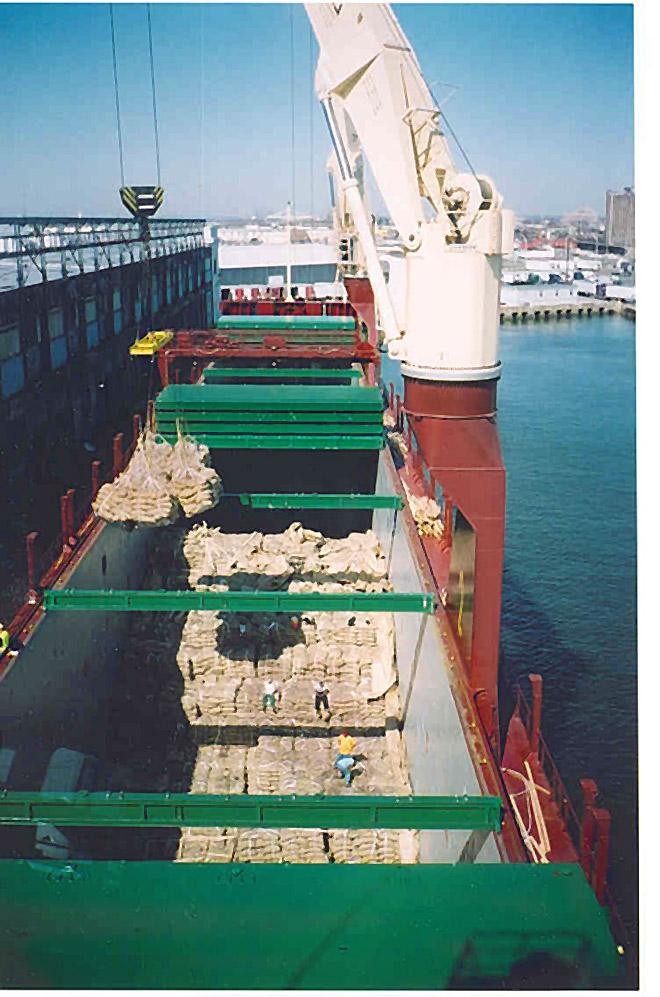
Almost half of all the cocoa beans that come to America–shipped from cocoa farms mostly in Ivory Coast and other West African places–sail up the Delaware River to the Port of Philadelphia and nearby ports. In Philly, the cocoa-bean facility is at Pier 84, where a warehouse about as long as three football fields is dedicated to cocoa handling and storage.
The beans show up here in burlap-type sacks, which have to be manhandled out of the hulls of cargo ships and onto the warehouse pallets. There are cranes and forklifts, of course, but it's still the kind of job for which an awful lot of the hardest work has to be done by hard workers.
Why is Philadelphia the port of entry for so many beans? Because Pennsylvanians make chocolate out of them, at factories all over the state, including a Godiva plant in Reading and a Hershey's operation in some town near Harrisburg with an amusement park. . . .
Feb 25, 2013
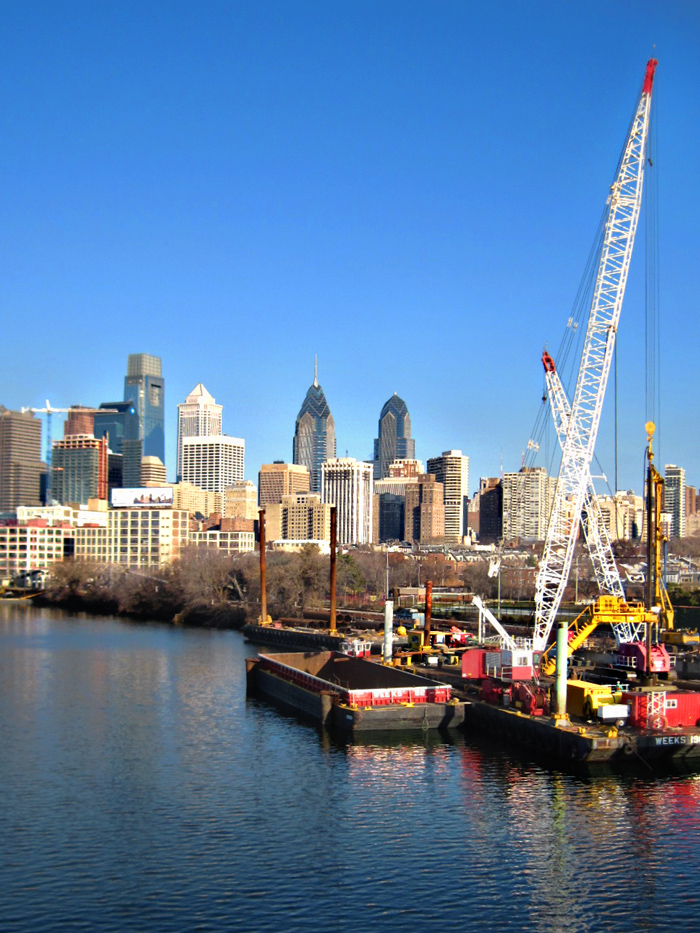 Yesterday, we caught the view from New York City's High Line rails-to-trails boardwalk, a park that winds along the western edge of lower Manhattan, thirty feet up in the sky.
Yesterday, we caught the view from New York City's High Line rails-to-trails boardwalk, a park that winds along the western edge of lower Manhattan, thirty feet up in the sky.
Today's glimpse of a tracks-to-boardwalk project is in Philadelphia, alongside the Schuylkill River, where barge-mounted heavy equipment is currently driving pilings into the riverbed for a boardwalk that will soar out over the water to extend an existing twenty-plus-mile asphalt biking and walking path.
The asphalt path follows an abandoned railroad bed downriver from Valley Forge past Fairmount Park and the Philadelphia Art Museum and on into Center City. But at Locust Street, the trail ends abruptly, crowded off the riverbank by half a dozen railroad lines that are definitely not-yet-abandoned.
The plan is to extend the path southward by snaking it out over the river as a boardwalk with observation platforms and maybe some fishing decks. (Although the Schuylkill is a bit shy of what you'd call a pristine river, there are definitely fish swimming in it, and they are catchable, if not eatable.)
After about half a mile over water, the new boardwalk will pass under the South Street Bridge and then curve back onto dry land for the remainder of its route. It will terminate in southwest Philly at Bartram's Gardens, an eighteenth-century homestead where America's earliest botanists planted the New World's first collection of botanical curiosities.
Planned completion date for the boardwalk is . . . early 2013, or so it is written. Whenever.
Mar 1, 2013
 They've been getting a lot of snow this winter in Maine–a foot last weekend and a record 29.3 inches early in February from the storm they called Nemo, and more before and since and in between. This photo was taken after Nemo, in Portland's Old Port.
They've been getting a lot of snow this winter in Maine–a foot last weekend and a record 29.3 inches early in February from the storm they called Nemo, and more before and since and in between. This photo was taken after Nemo, in Portland's Old Port.
Some Mainers are probably happy about it.
Here in Philly, we got nothing.
Oct 9, 2013
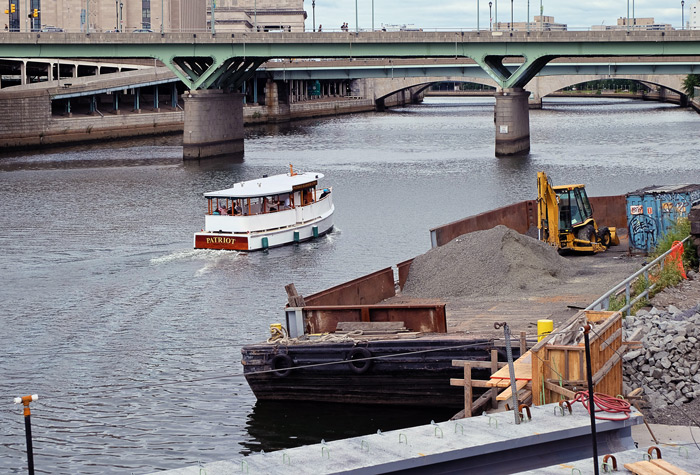 The little Patriot tour boat chugs up the Schuylkill toward the Walnut and Chestnut Street bridges.
The little Patriot tour boat chugs up the Schuylkill toward the Walnut and Chestnut Street bridges.
Visible in the lower righthand corner is construction work on a new boardwalk which will extend the Schuylkill Banks foot path and bike trail out over the river from Center City toward South Philly. "They" say the boardwalk should open in about a year.
Nov 3, 2013
By the sackful at Gavin's Cafe near Schuylkill River Park.
Nov 6, 2013
 Lily wraps one of her custom-created alliterative labels around a naked crayon at Crayola's play park in Easton, PA. Among her names for crayon colors: Lily Lemon, Lily Lollipop, Marvelous Mom, and Naughty Norman.
Lily wraps one of her custom-created alliterative labels around a naked crayon at Crayola's play park in Easton, PA. Among her names for crayon colors: Lily Lemon, Lily Lollipop, Marvelous Mom, and Naughty Norman.
In the huge Crayola factory just outside of Easton, where all 64 colors are melted and molded and labeled and boxed and shipped out to the world, the wrapping of labels is of course done by machine. But until the wrapping machines came on line in the late 1930s, that part of the process was farmed out to families in the Easton area, who would work at their kitchen tables wrapping labels around each crayon individually for a piecework wage. Each family worked on a single color, and the delivery routes were organized by color: e.g., turn left at the Green house and go up the hill to the Blue place.
Modern crayons first showed up at the 1904 World's Fair in St. Louis, where Crayola exhibited them as "dustless chalk," a healthful innovation for the classroom. The company that made them, Binney & Smith, was getting a little out of its comfort zone, since its main facility in Easton was a slate quarry, which provided slates for schoolrooms utilizing the non-dustless kind of chalk.
Today, Crayola's theme park and factory undergird the economy of Easton, which was once home as well to the headquarters of another corporation manufacturing the stuff American childhood used to be made of: Dixie Cups.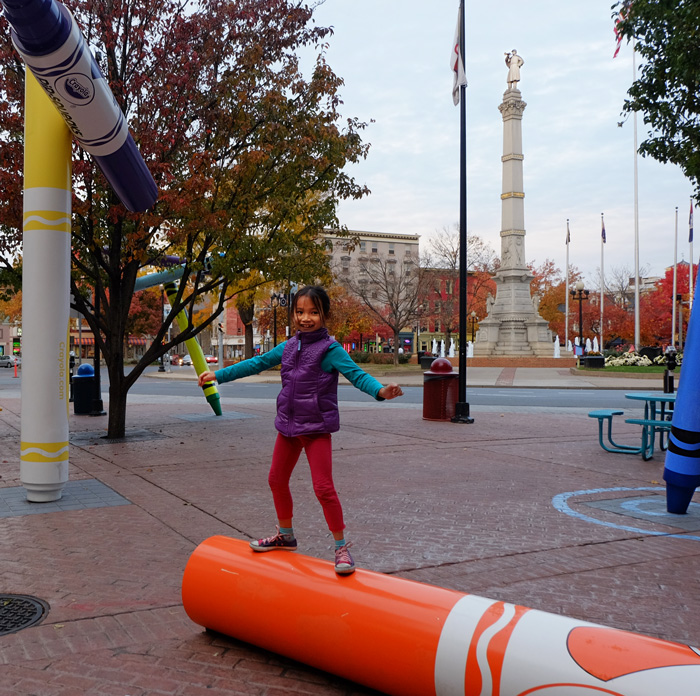
Nov 23, 2013
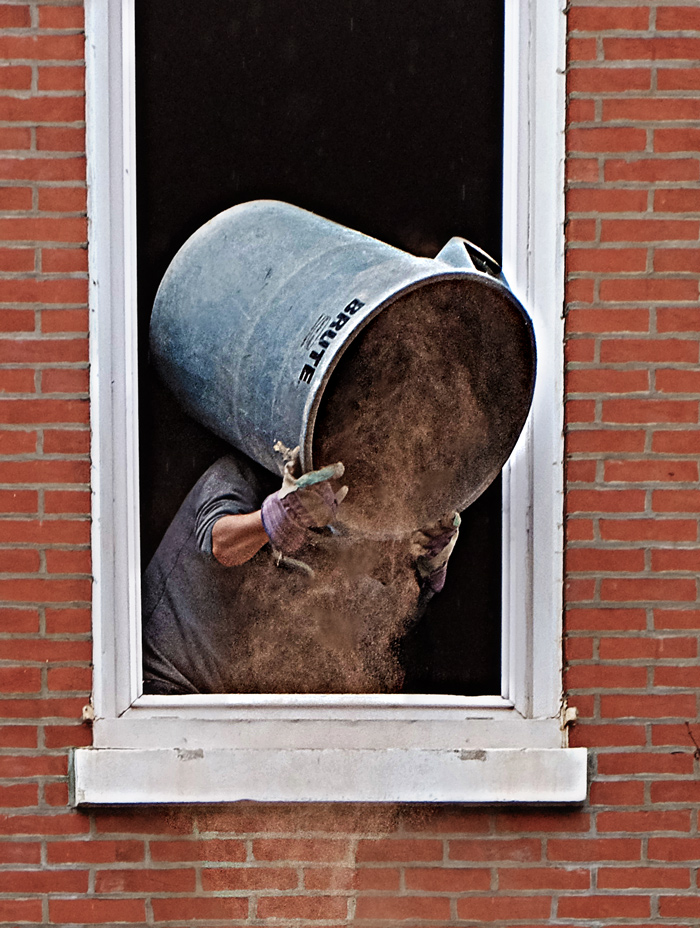 They're gutting yet another house in the neighborhood.
They're gutting yet another house in the neighborhood.
Nov 24, 2013
Thanks to the work of this volunteer and many hundreds of others, Philadelphia got 850 new street trees on Saturday, bringing the overall regional total of trees planted to–according to the calculations of somebody or other, as of Saturday night–exactly 262,236.
The goal is a million new trees, in hopes of restoring the forest canopy area heareabouts to 30%, which would provide enough shade to significantly mitigate the urban heat-island effect and would improve air and water quality, reduce erosion and water pollution, and lessen the frequency and severity of flooding.
The tree roots at bottom right in this photo belong to a variety of maple tree that is particularly hardy in urban settings and has a growth habit suitable for its new home in the urban jungle on South 21st Street, in front of a dentist's office and across the street from a dry cleaner's.
Mar 11, 2014
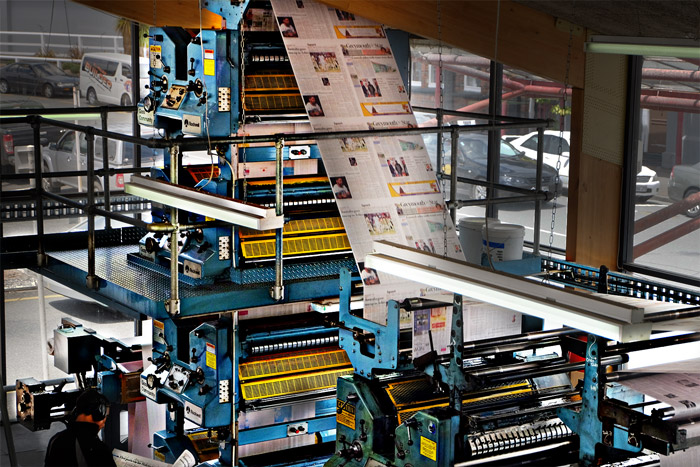 Back in March 1866, Greymouth was a rough little gold rush town on New Zealand's wild west coast, crowded with young men scheming to get rich quick, many of them immigrants from Ireland. While most of the town celebrated St. Patrick's Day that year, a man named Synder Browne huddled in a tent near the muddy outskirts of town, setting type by hand for the first edition of Greymouth's second newspaper, the Evening Star.
Back in March 1866, Greymouth was a rough little gold rush town on New Zealand's wild west coast, crowded with young men scheming to get rich quick, many of them immigrants from Ireland. While most of the town celebrated St. Patrick's Day that year, a man named Synder Browne huddled in a tent near the muddy outskirts of town, setting type by hand for the first edition of Greymouth's second newspaper, the Evening Star.
Greymouth's first paper, already a year old by then, was the Grey River Argus, which would become a Socialist tabloid. For the next century, the left-wing Argus and the right-wing Star would duke it out in the local marketplace of public opinion; their editors, it was said, took opposing positions on absolutely every public issue. Only once a year, on Christmas Eve, would the two editors get together for a holiday drink and some collegial conversation. Every other day of the year they spat and fussed in the competition for readers and for influence over Greymouth's affairs.
The town survived the gold rush, thanks to another mineral that had actually been discovered earlier but was initially ignored because it didn't glitter like you-know-what: coal. There was plenty of coal in the hillsides around Greymouth, though all the customers for coal, and all the ports suitable for coal shipping, were hundreds or thousands of kilometers away on the other side of the Southern Alps. Greymouth was a seaside town but without a decent harbor; it sat rough and damp in the nearly uninhabited rainforest along the west coast of New Zealand's South Island. To make a go of coal mining thereabouts, somebody was going to have to build a railroad over the mountains.
The Argus and the Star had different ideas about Greymouth's economic development. They argued for different people to pay for, and benefit from, the railroad project. When coal mining became established, the two papers argued even more fiercely over mine safety and environmental issues. The mines there have been productive but quite dangerous, with high concentrations of coalbed methane. Many miners have died over the years in mine fires and explosions, and several mine projects have been abandoned after methane levels proved uncontrollable. The Argus and the Star told different stories about the tragedies.
Most mines are closed now, and the town survives on forestry work and tourism; it is a portal to the glacier and fjord country further south. The population has leveled off at about 5,000, and there's only one newspaper left, the Greymouth Star. The Argus folded in the 1960s.
Today, the Star is owned by a publishing conglomerate based in Dunedin. And even though print media is in big trouble all over the world, the Star is hanging on, with subscribers all along the west coast and a workforce of more than 60 fulltime employees.
The Star is available online as well as on paper. In the latest edition, you can read about Charles Edward Miller Pearce, a New Zealand–born mathematician who taught at Adelaide University in Australia. He came home for a visit, rented a car at the Hokitika airport, just south of Greymouth, then drove south on the coastal highway until he apparently lost consciousness. His car landed upside down in shallow water, with only his head submerged.
"If he had been conscious, all he would have had to do was turn his head towards the middle of the car," a witness told the coroner, according to the Star's report, "and his face would have been out of the water."
"I observed that he had a peaceful expression on his face," noted a second witness. "My guess was that he fell asleep at the wheel and never woke up."
Mar 19, 2014
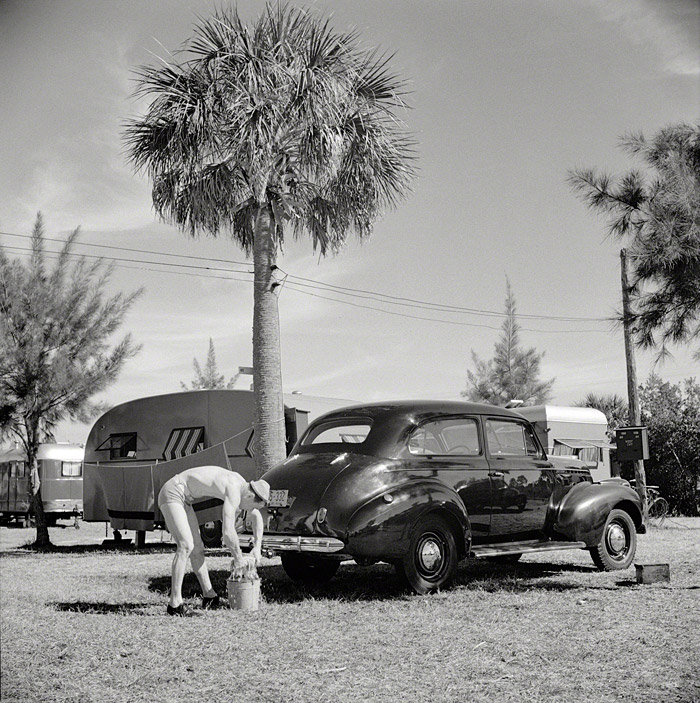 "Guest at Sarasota, Florida, trailer park washing his car," according to the notes of photographer Marion Post Wolcott. The picture was taken in 1941; the car is a 1940 Chevy Town Sedan with West Virginia license plates.
"Guest at Sarasota, Florida, trailer park washing his car," according to the notes of photographer Marion Post Wolcott. The picture was taken in 1941; the car is a 1940 Chevy Town Sedan with West Virginia license plates.
Jun 19, 2014
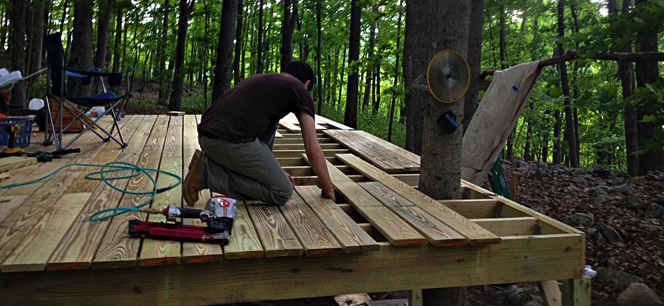 Ted lines up the decking for the new deck he's building behind his house high on the mountain near Berkeley Springs, West Virginia. "There is a big hickory and a skinny maple growing through the deck," he notes. "I still haven't done the railing. Sigh."
Ted lines up the decking for the new deck he's building behind his house high on the mountain near Berkeley Springs, West Virginia. "There is a big hickory and a skinny maple growing through the deck," he notes. "I still haven't done the railing. Sigh."
Jul 4, 2014
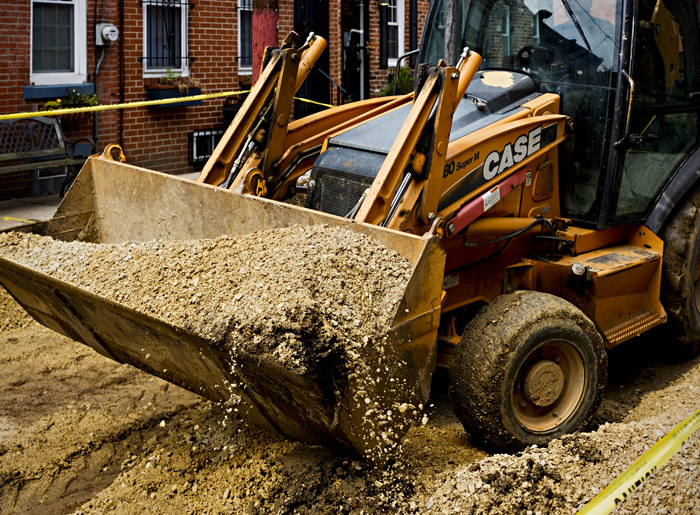 It's an important project, replacing century-old water mains underneath this stretch of Kater Street near us. It's also been a crazy dragged-out project, beginning last fall and not quite finished yet.
It's an important project, replacing century-old water mains underneath this stretch of Kater Street near us. It's also been a crazy dragged-out project, beginning last fall and not quite finished yet.
In the wintertime, the digging had exposed the water main and also the connecting water lines that served houses all up and down the street. Of course the pipes froze. Repeatedly. Ice and snow interrupted the work, repeatedly, often leaving our neighbors with no water.
In the springtime, the neighbors enjoyed the noise of heavy equipment at their doorsteps, all day, every day. All but one of the trees on the block were cut down. There was mud when it rained and dust when it didn't rain, and of course no parking.
Now it's July, and the workmen have closed their hole back up and are finally preparing the block for new asphalt and curbs and sidewalks. They promise new trees next fall.
All along, the work has been hard: cold, hot, and dangerous, with people living right there in the construction site. The street is so narrow and the houses so close to the hole that the excavator has to back up all the way to the end of the block to turn around between scoops of dirt.
As hard as it is, it's critical work for our children's future. We need a whole lot more investment like this, or our problems will no longer be the first world sort of problems.
Happy birthday, America.
Jul 9, 2014
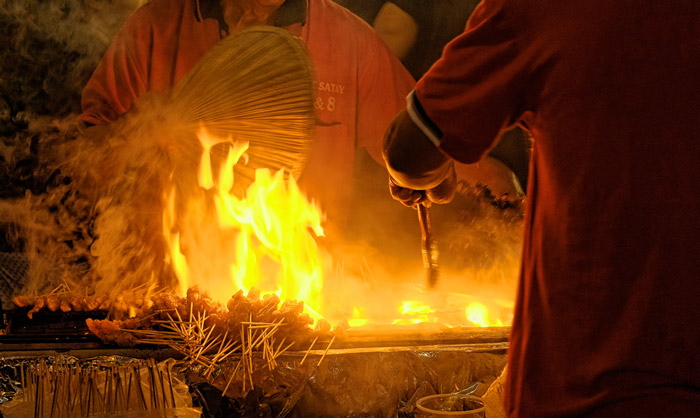 Saucing up the satay, at LauPaSat market in Singapore.
Saucing up the satay, at LauPaSat market in Singapore.
Jul 16, 2014
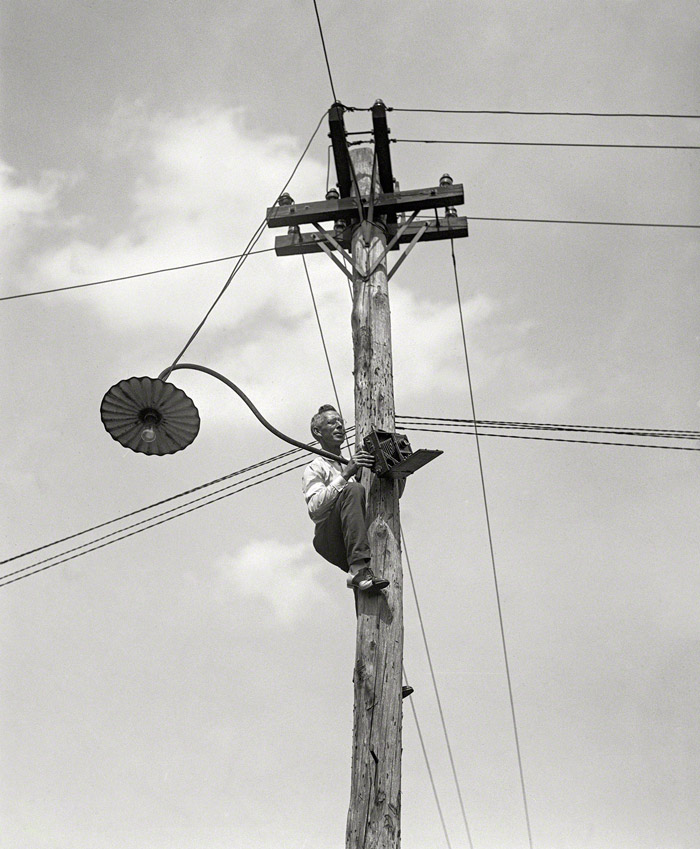 Photographer Artie Leonard snags a shot for the National Photo Company in 1923.
Photographer Artie Leonard snags a shot for the National Photo Company in 1923.
Aug 10, 2014
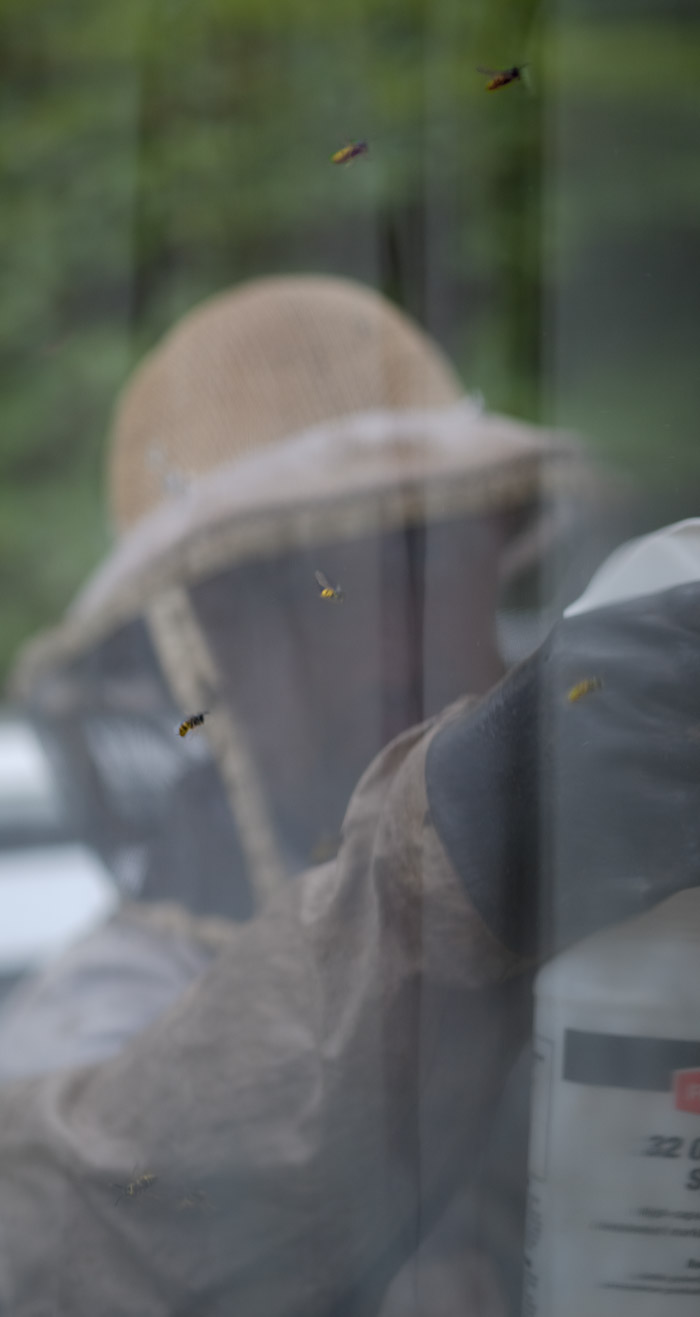 Above, in Seattle, getting rid of yellow jackets who've nested in the wall of the house beneath the shingles; below, in Philly, not yet getting rid of a wasp nest high in a tree on Kater Street.
Above, in Seattle, getting rid of yellow jackets who've nested in the wall of the house beneath the shingles; below, in Philly, not yet getting rid of a wasp nest high in a tree on Kater Street.
Aug 25, 2014
This is the story we heard Saturday on the street. Of course, none of it is confirmed.
So. There's this guy who bought a penthouse atop a nice new condo tower on 18th Street, half a block north of Rittenhouse Square. His unit includes a nice big terrace that wraps around at least two sides of the building; his views must include virtually all of downtown Philadelphia and beyond. Expansive, and no doubt expensive.
But not good enough. He didn't like his windows, we're told. He wanted to replace them with better windows and, apparently, more windows. He wanted lots and lots of really, really big windows. Three long trailer trucks full of windows.
Problem was, the new windows wouldn't fit in the elevator to get them up to his penthouse.
He needed a crane, and not just any crane. To operate in the cramped confines of a narrow city street laid out in the days of William Penn, the crane had to lift glass straight up for hundreds of feet and then rotate without bumping into any of the buildings thereabouts and deposit the glass gently on the penthouse terrace. Vehicular traffic could be blocked during this process, but not pedestrian traffic; nearby businesses wanted to keep their doors open the entire time.
There were only three cranes on the east coast, we were told, that could handle this sort of job. One of them was hauled to Rittenhouse Square on Saturday morning. In pieces.
Another crane was needed to help put the big crane together. In case you were wondering, the pieces are held together with big cotter pins.
Police officers were needed to direct traffic around the closed-off block. City buses were rerouted and sometimes delayed, forced into attempting painstaking tight turns onto streets not really suitable for them.
Two large crews of workmen were on duty all day, a crew of heavy equipment guys and a crew of glaziers from Local 262.
So there's the cost of the new windows, and of a rare, expensive crane that had to be assembled by a second crane, plus three tractor trailers to haul in the windows, various vehicles to haul the parts of the cranes, two crews at union wages, lots of expensive permits to block a street and redirect traffic and park all the trucks all day . . .
And then later, after all the new windows are up on the penthouse terrace, there will be the expense of removing the old windows, redoing the walls to accommodate the new windows, installing them . . .
We were told $250,000. Does that sound right to you?
Sep 16, 2014
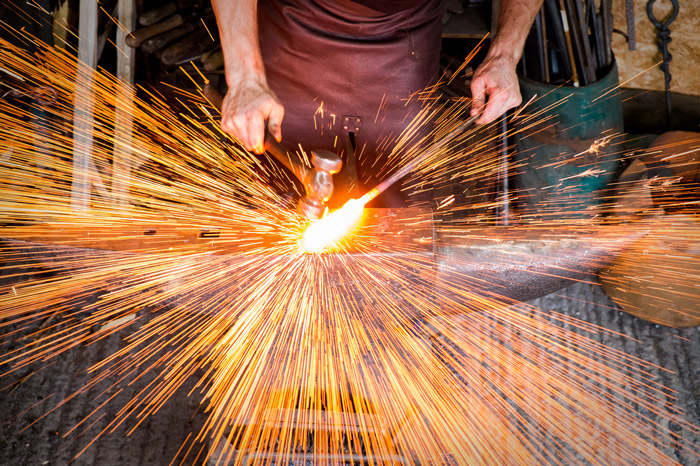 Blacksmith Michael Hart of Horsmonden, Kent, U.K., beats an old chainsaw chain into a new knife.
Blacksmith Michael Hart of Horsmonden, Kent, U.K., beats an old chainsaw chain into a new knife.
Hart tries to keep the fire in his forge at about 1200 degrees Fahrenheit. Each time he pulls his work out of the fire, it glows white-hot and his first hammer blow releases a shower of sparks. Succeeding blows do less glitzy work.
Nov 4, 2014
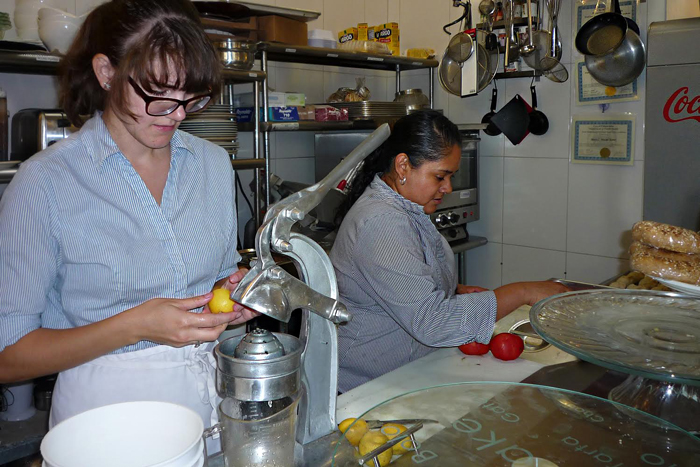 Around the middle of every October comes a day declared Philly Photo Day by the Philadelphia Photo Arts Center. Anybody who happens to be in Philly that day with any kind of camera, even a cellphone, is invited to submit a snapshot that captures a smidgen of what's going on, on that day, in this city.
Around the middle of every October comes a day declared Philly Photo Day by the Philadelphia Photo Arts Center. Anybody who happens to be in Philly that day with any kind of camera, even a cellphone, is invited to submit a snapshot that captures a smidgen of what's going on, on that day, in this city.
The nineteen hundred photos turned in this year, for the fifth iteration of the event, will be displayed next April in the new Dilworth Park plaza at City Hall.
Above is Katrin Maldre's submission, showing the action behind the back counter at Gavin's Cafe in Fitler Square. Below is my entry, featuring Grand Opening balloons outside a new pet-supply store on South Street.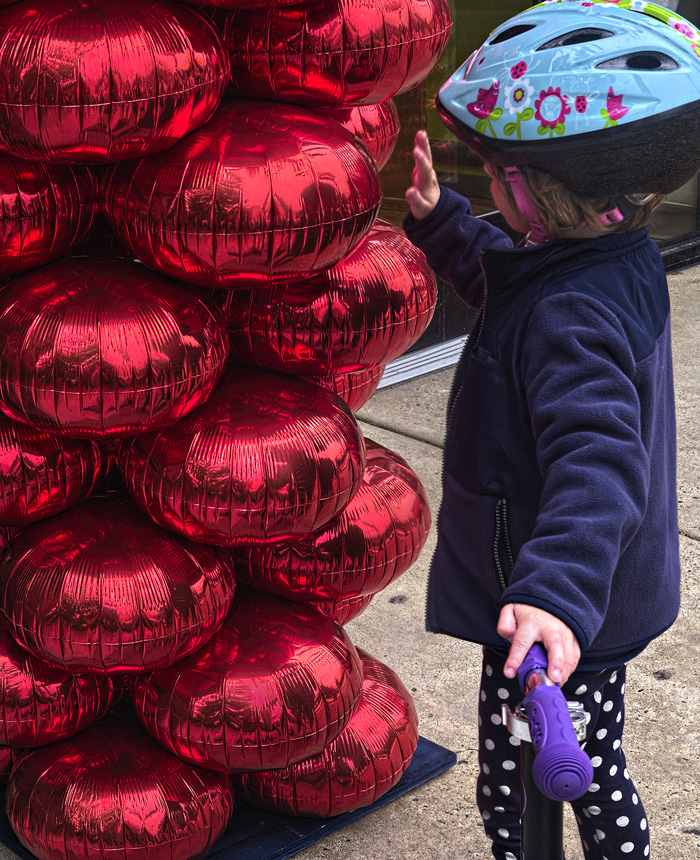
Nov 5, 2014
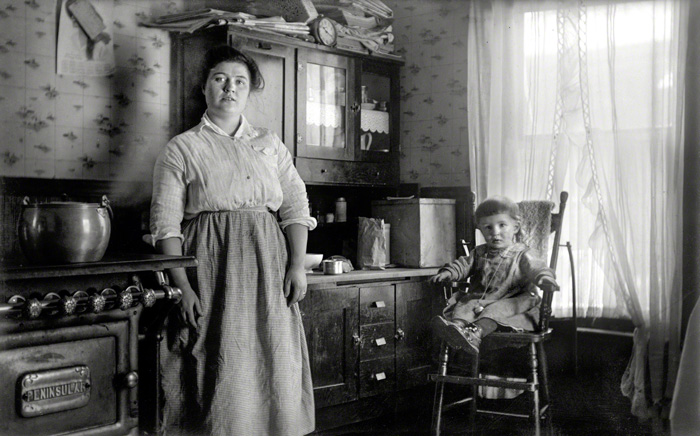 Shorpy tells us the hundred-plus-year-old glass plate that produced this photo is something he bought on eBay. Apparently, nothing is known about the image, except that it features photographic technology, and perhaps also props and fashion, that date it to approximately 1910.
Shorpy tells us the hundred-plus-year-old glass plate that produced this photo is something he bought on eBay. Apparently, nothing is known about the image, except that it features photographic technology, and perhaps also props and fashion, that date it to approximately 1910.
The brand of the stove, Peninsular, suggests the location may be southern Michigan or northern Ohio.
All in all, what we've got here are two unknown people in an unknown kitchen, taking a moment from their unknown lives to look us right straight in the eye, from the distant shores of the early twentieth century.
Note that they've been saving old newspapers up on top of the cabinet.
Nov 3, 2014
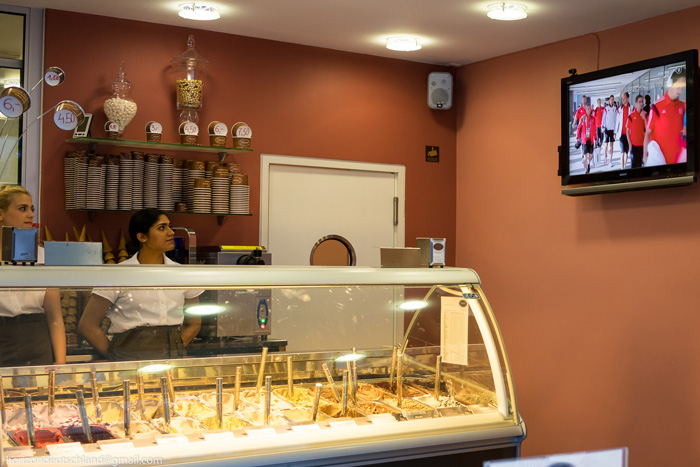 Back in June, the women working behind the counter at this ice cream place in Germany took a break to watch the German national team win the 2014 World Cup in Brazil.
Back in June, the women working behind the counter at this ice cream place in Germany took a break to watch the German national team win the 2014 World Cup in Brazil.
Next June, there will be another soccer World Cup competition, this time hosted by Canada and featuring women's national teams. Last month in Philadelphia, the U.S. women officially qualified for the 2015 tournament by beating Mexico 3-0 and then Costa Rica 6-0 to claim the regional CONCACAF Cup. A clear majority of the 12,000-plus spectators cheering them on were women and girls.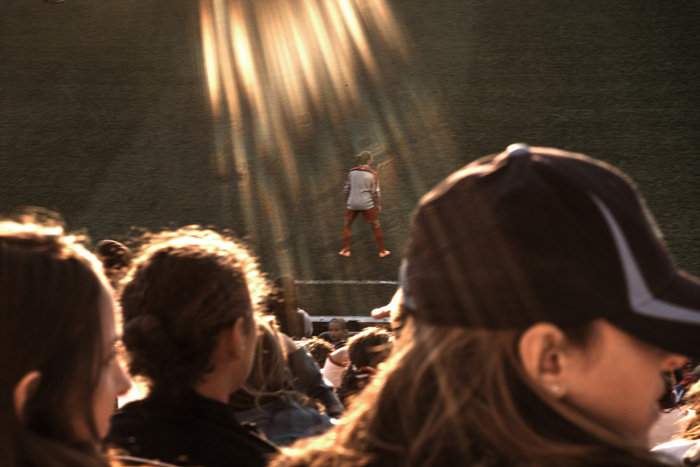
Nov 13, 2014
 Picking up the pieces last summer in the plaza at downtown Seattle's Westlake Mall.
Picking up the pieces last summer in the plaza at downtown Seattle's Westlake Mall.
Jan 27, 2015
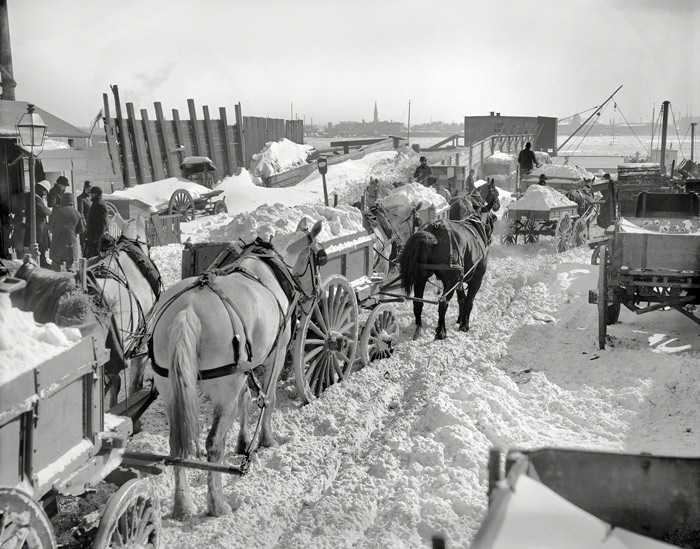 In 1899, snow was shoveled off busy Manhattan streets, loaded into wagons, and hauled down to the docks, where it was dumped in the river.
In 1899, snow was shoveled off busy Manhattan streets, loaded into wagons, and hauled down to the docks, where it was dumped in the river.
Nowadays, the EPA doesn't like for states or municipalities to dump dirty snow from city streets into rivers or, as in the case of Portland, Maine, into the ocean. Portland used to throw its snow from downtown into the harbor, but it now builds mountains of snow, dump-truckload after dump-truckload, in an empty field near the airport.
New York City trucks its snow to melting machines, known as snow dragons, which can melt thirty tons of snow an hour and discharge the meltwater into the city sewer sytem. In an emergency, however, such as a ridiculously huge blizzard, we are told that the EPA will look the other way while the city rids its streets of snow the old-timey way.
Feb 2, 2015

Portrait de la la Repasseuse, by Laura Corrado, from the 2015 Royal Photographic Society International Biennial.
Feb 20, 2015
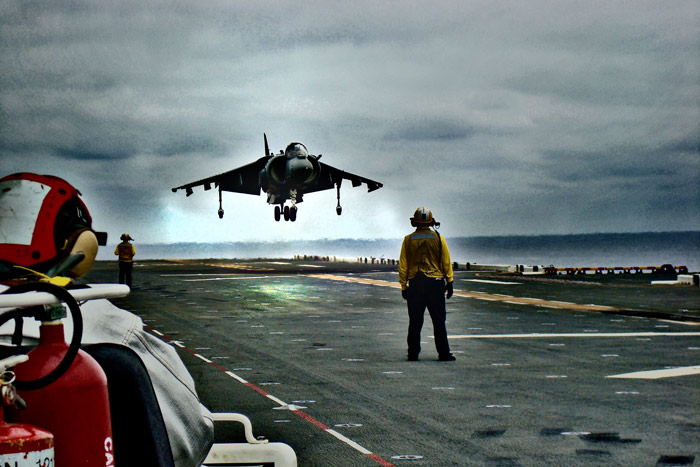 Somewhere in the eastern Pacific, a Harrier jump jet prepares to drop down onto the deck of the USS Bonhomme Richard.
Somewhere in the eastern Pacific, a Harrier jump jet prepares to drop down onto the deck of the USS Bonhomme Richard.
Mar 1, 2015
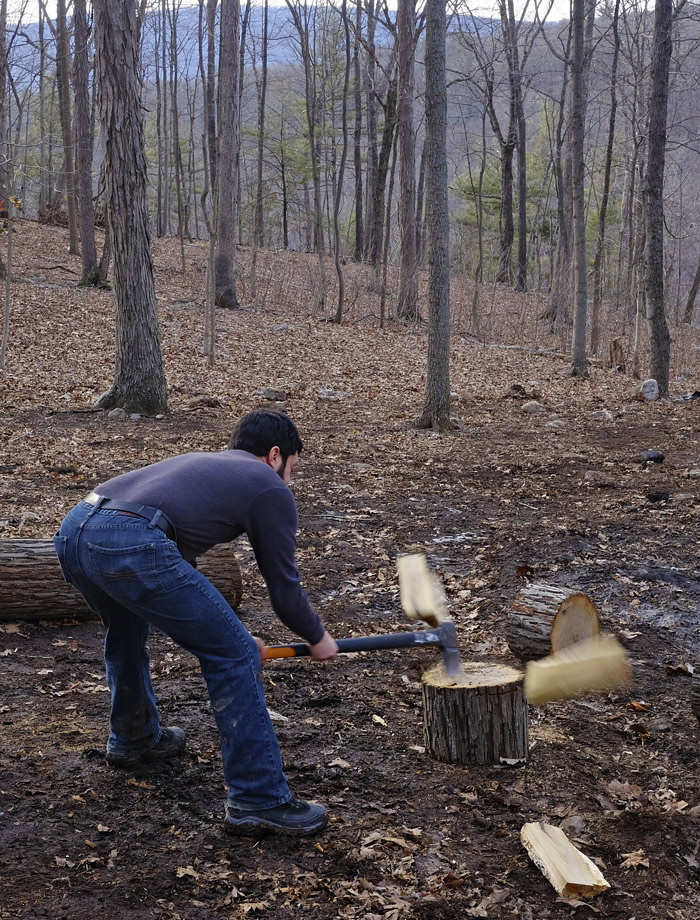 Up in Tedland, high on the mountain above the Cacapon River, to get warm at all, you have to get warm twice. Or else wait till June and get all the warm you want, and then some.
Up in Tedland, high on the mountain above the Cacapon River, to get warm at all, you have to get warm twice. Or else wait till June and get all the warm you want, and then some.
Apr 30, 2015
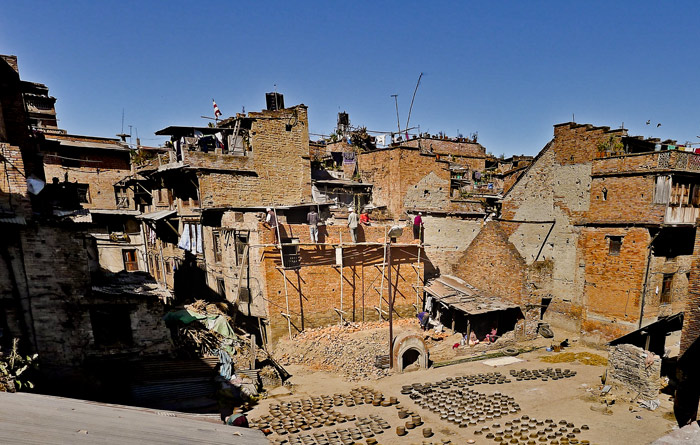 In the best of times, such as when this photo was taken about four years ago, repairing houses and other buildings in Nepal involved scaffolding made from stalks of bamboo lashed together.
In the best of times, such as when this photo was taken about four years ago, repairing houses and other buildings in Nepal involved scaffolding made from stalks of bamboo lashed together.
In the worst of times, such as right now, even this sort of construction work is an unimaginable luxury; all hands, and all hours of the day, are consumed by pawing through rubble, hoping or fearing to find relatives and friends and neighbors, and also hoping to find scraps of food and clothing and blankets, anything that might help the survivors cling to life.
There's nowhere to look for the basics of survival except in the rubble. There was no surplus of anything in Nepal to begin with, and only a single sizable airport for bringing relief in from the outside world.
Before these men could climb up on the scaffolding to lay brick, the sacks of mortar had to be brought in on the backs of people or donkeys; the streets here in this UNESCO World Heritage city of Bhaktapur, near Kathmandu, were much too narrow for cars or trucks.
Now even the country's best roads are ruined, and travel through the narrow lanes and paths is generally impossible. Some villages that used to be a day's walk or more from the nearest highway have not been heard from since the quake.
Bhaktapur was once a great royal court city; grand palaces and temples survived there for more than a thousand years. They're not there any more.